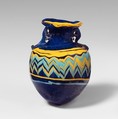Glass aryballos (perfume bottle)
Translucent cobalt blue, with same color handles; trails in opaque yellow and opaque turquoise blue.
Broad uneven inward-sloping rim-disk; short cylindrical neck; sloping shoulder; ovoid body; convex pointed bottom; two vertical ring handles with knobbed tails, applied over trail decoration, extend from top of body to underside of rim-disk, with a long trail extending from one handle across shoulder to the other; handles are not directly opposite each other but rather more to one side.
A yellow trail applied unevenly to outer edge of rim-disk; another yellow trail applied on shoulder and wound spirally, at first in horizontal lines, then tooled into a zigzag pattern around central section of body, formed by shallow vertical tooling indents, where a turquoise blue trail is added, mingling with the yellow; below this, a yellow trail and a turquoise blue trail wound unevenly once around body.
Broken and repaired with parts of lower body missing; small patches of dulling and pitting.
Glass vessels such as these first appeared in the Greek world late in the sixth century B.C. They originally contained perfumes or scented oils used in funerary rites, after which the bottles were left in the grave.
Due to rights restrictions, this image cannot be enlarged, viewed at full screen, or downloaded.

